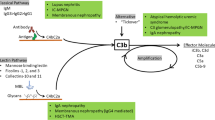Summary
Ten renal transplant recipients showing a significant increase in human polyomavirus antibodies, indicative of an acute infection, were followed up serologically over periods ranging from two months to more than two years. Fifty-four serum specimens were available for the study and they were tested by both haemagglutination-inhibition and complement-fixation. Polyomavirus antigens were prepared from the BK and SV 40-like strains of polyomaviruses, and from the SV 40 virus. One strain of polyomavirus, related to the BK strain, was isolated from the urine of one of these patients. Two other BK strains were recovered from the urine and kidney, respectively, of transplant recipients not included in this study. Sera of these two patients were not obtained until the transplantation was made; they were already highly positive for polyomavirus antibodies, precluding the demonstration of an increase in antibody titer.
Serologic results have shown that HAI antibodies persist at high titers throughout the observation period. This persistence ranged from two to four months (four cases), seven to eleven months (three cases) and thirteen to twenty months (three cases). In none of the cases could a decrease of high titer be demonstrated. Moreover, density gradient studies have shown that specific IgM antibodies also tend to persist over many months.
Similar serologic results were obtained in complement-fixation tests with a BK antigen. Titers were at least 1 in 30 in the study group, but were not observed among healthy blood donors. All sera were uniformly negative for SV 40 and SV 40-like antigens.
One polyomavirus isolation was successful from urine obtained six months after initial serologic evidence for a polyomavirus infection. The other two viruses were isolated from materials taken four and seven months after first detection of polyomavirus antibodies at high titer.
Both serologic evidence and viral isolations seem to indicate that polyomaviruses (BK type) might cause a chronic infection in humans.
Similar content being viewed by others
References
Coleman, D. V., S. D. Gardner, andA. M. Field: Human polyomavirus infection in renal allograft recipients. Brit. med. J.3, 371–375 (1973).
Gardner, S. D.: Prevalence in England of antibodies to human polyomavirus (BK). Brit. med. J.1, 77–78 (1973).
Gardner, S. D., A. M. Field, D. V. Coleman, andB. Hulme: New human papovavirus (BK) isolated from urine after renal transplantation. Lancet1, 1253–1257 (1971).
Krech, U., andM. Jung: Antigenic relationship between human cytomegalovirus, herpes simplex and varicella-zoster virus studied by complement-fixation. Arch. ges. Virusforsch.33, 288–293 (1971).
Krech, U., M. Jung, P. C. Price, G. Thiel, D. Sege, andF. Reutter: Virus infections in renal transplant recipients. (To be published.)
Manz, H. J., M. D. Dinsdale, andP. A. F. Morrin: Progressive multifocal leukoencephalopathy after renal transplantation. Ann. int. Med.75, 77–81 (1971).
Padgett, B. L., D. L. Walker, G. M. Zu Rhein, R. J. Eckroade, andB. H. Dessel: Cultivation of papova-like virus from human brain with progressive multifocal leukoencephalopathy. Lancet1, 1257–1260 (1971).
Padgett, B. L., andD. L. Walker: Prevalence of antibodies in human sera against JC virus, an isolate from a case of progressive multifocal leukoencephalopathy. J. infect. Dis.127, 467–470 (1973).
Penney, J. B., andO. Narayan: Studies of the antigenic relationships of the new human papovaviruses by electron microscopy agglutination. Infection and Immunity,8, 299–300 (1973).
Robinson, R. Q., andW. R. Dowdle: Influenza viruses. In: Diagnostic Procedures for Viral and Rickettsial Diseases. A.P.H.A., 4th ed., pp. 414–433 (1969).
Shah, K. V., R. W. Daniel, andR. M. Warszawski: High prevalence of antibodies to BK virus, an SV 40-related papovavirus, in residents of Maryland. J. infect. Dis.128, 784–787 (1973).
Weiner, L. P., R. M. Herndon, O. Narayan, R. T. Johnson, K. Shah, L. J. Rubinstein, T. J. Preziosi, andF. K. Conley: Isolation of virus related to SV 40 from patients with progressive multifocal leukoencephalopathy. New Engl. J. Med.286, 385–390 (1972).
Weiner, L. P., O. Narayan, J. B. Penney, R. M. Herndon, E. R. Feringa, W. W. Tourtellotte, andR. T. Johnson: Papovavirus of JC type in progressive multifocal leukoencephalopathy. Arch. Neurol.29, 1–3 (1973).
Author information
Authors and Affiliations
Additional information
With 5 Figures
Rights and permissions
About this article
Cite this article
Jung, M., Krech, U., Price, P.C. et al. Evidence of chronic persistent infections with polyomaviruses (BK type) in renal transplant recipients. Archives of Virology 47, 39–46 (1975). https://doi.org/10.1007/BF01315591
Received:
Issue Date:
DOI: https://doi.org/10.1007/BF01315591




